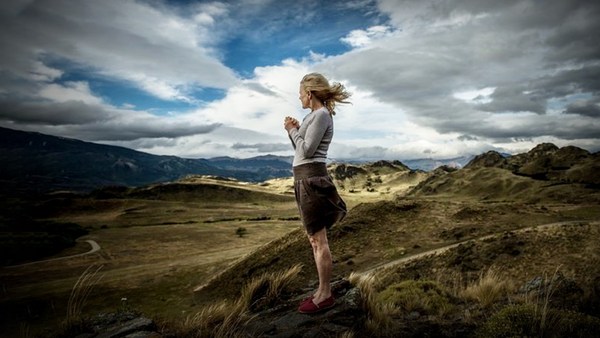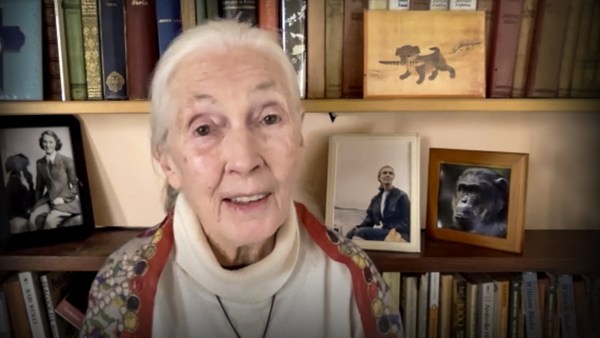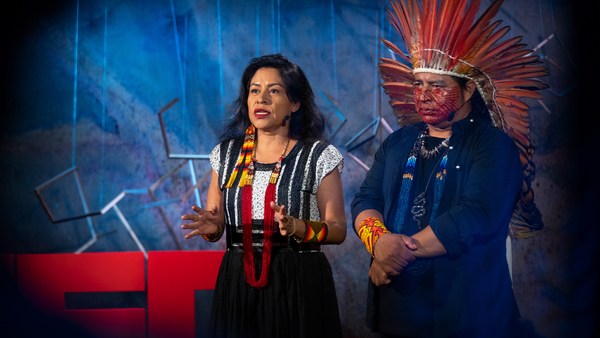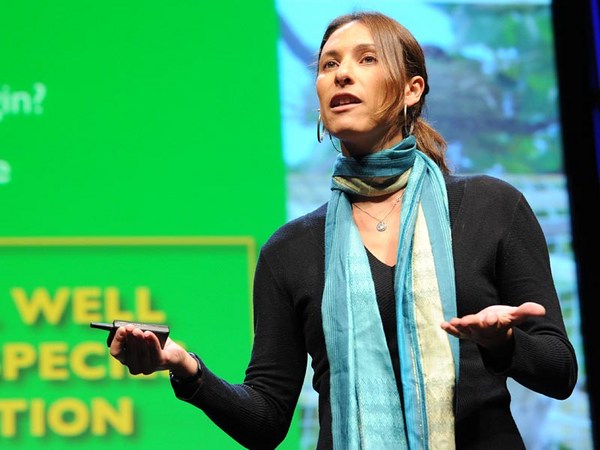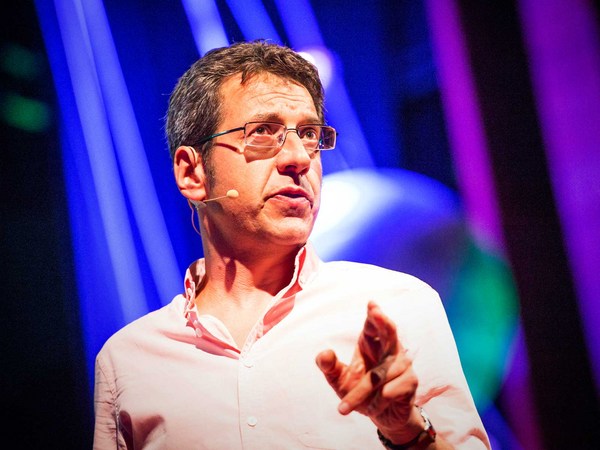So, human relationships with animals can be pretty weird. We put them in categories based on how we see them. So there's pets and they're, like, members of the family. And then there's farm animals and they're often very similar to pets in terms of their cognitive abilities and their emotional abilities. But of course, we eat them. And then there's wild animals. And I've been wondering what wild animals even are anymore. Like, you can get a degree in wildlife management, but if you're managing them, are they really wild?
I started thinking about this in the context of wolf reintroduction. So when wolves were first brought back to the American West in the 1990s, they were pretty heavily managed and they still are today. A lot of them wear collars, they have GPS trackers, they have their DNA on file, they have names and numbers. And if they get a taste for livestock, then we haze them with rubber bullets or air horns, or sometimes those, like, floaty guys that you see in used-car lots. And of course, if they don't get the message, they can be shot. So how wild are they really if they're being this carefully managed? It's occurred to me that a ground squirrel or a city robin is in some ways wilder than these wolves, because although they might live in a city, no one is managing their day-to-day life.
But of course, they are living in a human world. A world that's been shaped by massive influences like conversion of land to agriculture, extinctions, domestications, movement of species across continent. And we've rerouted rivers. And of course, there's climate change, which means that every animal, no matter how distant from a human settlement, has some influence of the human world. So if every animal lives in a human world, does that mean that we somehow owe them more than we used to? I think it does.
So take polar bears, for instance. Some populations of polar bears are struggling to live on the sea ice in the summer. There's just not enough sea ice for them to go hunting for seals, which is what they'd normally eat. So I think we should consider feeding them for at least part of the year. Now, there'd be a lot of logistical challenges with this we'd have to work out. And certainly we would want to make sure that the Inuit who have lived with these bears and hunted them for millennia would be on board with any plan. There might be other ethical obligations that supersede our obligation to care for the bears, like, we'd have to think pretty hard about where we get the meat that we feed them, or if it'd be possible to feed them some kind of plant-based polar bear chow that would meet all their requirements. So these are not easy questions, but I think we should be thinking about them.
On the other hand, if we really want to see animals happy, we need to start asking what that full happiness looks like, what does it mean for an animal to really flourish? So this would go beyond just being well-fed and healthy and it might include something like freedom or at least the ability to make your own choices day-to-day. A few years back in Washington State, there was this dog that ran away from his home and joined up with two wolves and they formed a little pack. And wildlife managers were very nervous about this because they didn't want the dog impregnating either of the wolves because any puppies would be hybrids. They would be neither domestic nor wild. They wouldn't fit into either category. Regulating them or figuring out what to do with them would be a nightmare. So they tracked the pack down and when they found that one of the wolves was indeed pregnant by the dog, they ended her pregnancy. So in that case, the sort of purity of the wolf, or the genetic wildness of the wolf, was deemed to be more important than its actual autonomy.
I'd like to say that there's some sort of algorithm that I could give you that would always help you decide what to do in any given case with wild animals. But I bet you saw this coming when I tell you that there aren't really any easy answers to this. The tricky thing is that sometimes we're having to compare things that are not in the same currency, so to speak, right? So what I really struggle with are situations where biodiversity trades off against animal welfare or the well-being of individual animals. So there's actually a lot more of these conundrums than you might think. Like in New Zealand, for example, tons of iconic animals like the Kiwi are threatened by introduced predators, including stoats, which are, like, this cute furry little weasel. So do you kill the introduced predators to save the endangered species?
In questions like these, I don't think there really are "right" answers. I think we just have to do the best when we're comparing apples and oranges, a species versus the welfare of many individuals. All we can do is our best, working together and trying to act with humility.
We've really changed the world and all of the animals that live in it now are basically living in our world. I think this gives us new responsibilities. In this world we've created, it's time for us to take those responsibilities to other species seriously.
Thanks so much.
David Biello: That was excellent. Thank you. And I know it was a short talk, so I want you to expand upon it a little bit. You talked about our ethical obligations to these wild animals. What do you think those specifically are, after the journey of writing this book?
Emma Marris: Well, I do think that because we have created this world, that because there's so much human influence, that we do bear some kind of collective responsibility, especially in situations where we can clearly see that animals are suffering or not doing well because of our influence. So there's a sort of a very intuitive ethical relationship there. If you actually knock someone over in a crowd, you feel like you have the responsibility to pick them back up. So I think there's a kind of a parallel there. But I also think that if we have obligations to wild animals that go beyond just letting nature take its course, then I think we have to learn more about them to figure out how to best serve them. And I think that includes figuring out what really makes them flourish. And I do think that that kind of flourishing -- And this is the word that you see in discussions about Aristotle, right, like, the flourishing of a human -- But to think about a flourishing of an animal is a little more complicated. But I do think that for many animals, especially animals that are close to us on the taxonomic tree of life, like chimpanzees and other large mammals, that being able to make your own choices is part of that flourishing. So that means we want to balance our intervention with our respect for their autonomy. And I think that's really tricky sometimes.
DB: So let's turn to some audience questions. Starting with Kim, who I feel may have read your recent op-ed in "The New York Times." "How do you feel about zoos or sanctuaries for wild animals?" Is there a better way to protect them? And is there a better way to spend time with animals, which is what zoos offer, and have them accessible to humans, but also be sure that the animals' kind of flourishing comes first?
EM: Right. Thanks, Kim. I did write a piece about this recently, and the piece is sort of drawn from the book. So if you enjoyed that piece, there's more goodness in the book. But I do think -- After researching zoos and the sort of happiness level of animals in zoos, I came to realize that there's a sort of a problem with the business model of zoos, which is that the very animals that are most likely to get people in the door, are the ones that do the worst in captivity. So there's a real problem there, which is that if zoos got rid of all of the animals that tend to show kind of behaviors that show they're unhappy, like pacing or rocking or repetitive behaviors or other kinds of behavioral problems, they'd be left with animals that aren't as much of a draw. So I think that puts them in an awkward position. I do think that zoos should stop breeding animals that aren't a part of a sort of a legitimate conservation breeding program that has a real chance of going back out into the wild someday. So I think it's a lot easier to ethically justify breeding animals in captivity if they or their grandchildren are someday going to taste freedom again. But if you're just breeding tigers and elephants over and over again just for display in captivity, I don't think that's great. Every time I see the birth announcement of some new adorable gorilla baby, my heart breaks a little bit because I know this gorilla baby is never getting out. That's not like, you know, this gorilla is going to spend its formative years at the such-and-such zoo and then it's going to return to the jungle. That's not happening. Sanctuaries are a different proposition. So sanctuaries don't breed their animals. They just take care of animals that can't return to the wild for one reason or another. So I think that they're at a much better place ethically.
Oh, but let me address the question of how you then see animals, right, if we remove these breeding populations of fun animals from zoos, how do you have that experience? Well, first of all, there is an amazing ability for us to virtually interact with animals through nature documentaries, which are better than ever. I actually wrote about them recently, too, but their filming can get you closer to a wild animal than you would ever be wise to do in the real world. But I also think that we need to sort of reshift our thinking a little bit around the animals that exist in our own ecosystems, even in our city ecosystems, right? You can see a surprising diversity of bird life, insect life in some case, and mammal life inside even very busy cities. And realizing that those animals are really awesome, too, and just because they aren't elephants, we've forgotten to take pleasure in encountering them. I think a perspective shift there can be really helpful.
DB: Now, Catherine and Gordon want us to take this to the sea. How does this all apply to sea creatures, which are obviously in a far different position than the land animals? But there are more of them, right?
EM: Yes, great question. First of all, I think that many of my critiques of zoos apply to aquaria as well. And, you know, certainly there has been a real public discussion about the captivity of whales and other marine mammals. So I think the tide is turning on that. I did read, while I was researching this book, I read a book that I recommend by Jonathan Balcombe about the secret lives of fish, which really did blow my mind in terms of the cognitive abilities of fish. And I think that many of us have grown up with this idea that fish are somehow dumber than land animals or that they don't, you know, that they don't feel pain, is a common thing that people have said about fish. This is not true. So I think that much of this applies to, you know, to the marine world as well. And in the book, I talk about, you know, what can we do for wild animals? And honestly, one of the biggest things we can do is try to address climate change and habitat destruction. That's really the biggie, because then we'd have fewer of these confusing conundrums where we have to decide whether or not to intervene in these complicated ways. If they have more space and they have a more stable climate, they can do a lot of flourishing on their own and we don't have to get into as many moral dilemmas. So honestly, if you find these ethical pickles uncomfortable, the best way to avoid the ethical pickle is to create a lot of stable habitat for non-humans.
DB: So you mentioned the Inuit earlier and their special relationship with the polar bear. Is there a way that we could better, kind of, steward wild areas, Lynn wants to know, and perhaps the folks who have been living alongside those wild animals the longest could be paid or hired in some way to be caretakers of that wild environment?
EM: Yeah, I think that is kind of how the conservation movement is trending, honestly, I think indigenous protected areas are the sort of hot new topic in conservation. They're getting set up in different parts around the world. Canada has just announced quite a few of them over the last five years. There was a paper that came out recently that got a lot of attention, showing that in Australia, Brazil and Canada, indigenous protected areas have higher levels of biodiversity than parks, suggesting that, yes, those management approaches that are millennia-old are really effective in keeping a kind of a multi-species-community going. So I think there's a lot of interest in that, a lot of hope that could be a way forward. In the book, I talk about going to the Peruvian Amazon, where there's a big park called Manu, which is one of the highest biodiversity parks probably on Earth, and they have people living inside of it, the Machiguenga, and some more sort of old-fashioned conservationists feel that the presence of the Machiguenga in the park is a problem because they hunt there. But it seems pretty clear from the research I read and from my time that I spent in the park that they're actually acting as de facto biodiversity managers and guards. And yes, they're hunting, but they're hunting in a sustainable way. So, yeah, I think that this is honestly the best way forward, right, because it marries the sort of justice cause of indigenous sovereignty with the pragmatic cause of getting the people who are best qualified to manage landscapes on the job. So, yes, I agree with Lynn completely.
DB: Amazing. Well, thank you again for this wonderful talk and conversation. And it truly is a great book. Best of luck with with everything.
EM: Great. Thanks so much.
DB: Goodbye and thank you.
[Get access to thought-provoking events you won't want to miss.]
[Become a TED member at ted.com/membership]
